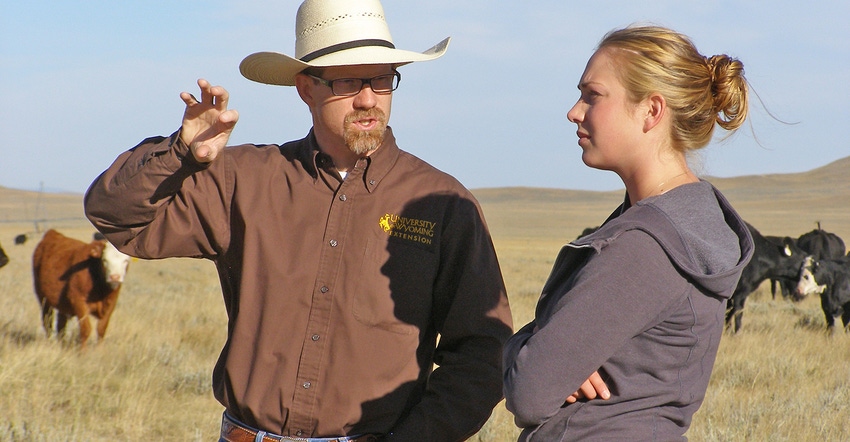September 25, 2017

Editor’s note: This is the second story in a series exploring the benefits of fitting the cow to the environment.
Smaller cows dramatically outperformed larger animals in a Wyoming rangeland study, and the lead researcher is confident the results could help ranchers across the region bolster profits over the long haul.
“Our research was very specific to a high-altitude Wyoming range setting, but it supports results from studies conducted in states with similar environments, including Montana, but also in much more productive environments to the east,” says Derek Scasta, University of Wyoming Extension rangeland specialist.
“Bottom line, our study and similar projects show that smaller cows are the most efficient from a forage input-calf output perspective, and I believe the results apply from the Great Plains across the West.”
Fortunately for the Wyoming researchers, weather conditions varied from average precipitation to severe drought to abnormally wet over the four years of the study. This allowed them to see performance across a range of conditions.
The team found smaller-sized cows had much higher efficiency ratios than larger cows across this wide-ranging precipitation cycle, and the smallest cows were the only ones to wean 50% of their body weight.
“The fact that the smaller cows were always more efficient and were the only ones to reach that 50% target indicates you could have more cows in your herd that are more efficient,” Scasta emphasizes. “And that, ultimately, could affect the economics of your cow herd in a positive way.”
Building a herd of smaller cows will take time, just like it did to develop big cows.
“It took many years for most ranchers to go from the 1,000-pound cow that you used to see in the 1970s to that 1,400-pound cow you see today,” Scasta says. “It has been a slow trend, but over time, the greater demand on forage has crept up on some ranchers.”
Forage efficiency
In some cases, that has negatively affected range conditions and ranch sustainability.
“If you are trying to run the same number of cows but those cows are larger, they require much more grass,” Scasta says. “So ranchers end up trying to balance animal demands in terms of what they need to survive, and produce a calf every year with the forage supply and rangeland resources.”
The study found that the smallest cows required approximately 3,930 pounds of forage over the 210-day period from birth to weaning, while the largest cows required nearly 5,000 pounds.
“So when ranchers calculate stocking rates, they need to really think about animal size,” Scasta says.
He then asks: “Do you know how much your cows weigh today compared to the last couple of decades, and do you know what kind of demands those cows are putting on your forage resources?”
If you don’t, he says, it’s a questioning worth exploring.
The Wyoming study, which was conducted on a high plains ranch at an elevation of 7,200 feet, found that the 5,550-acre parcel would support 237 smaller cows, but only 186 large animals if the herd was uniformly composed of same-size cows.
“That’s 51 less calves at weaning time,” Scasta points out. “So, if stocking rates are managed in concert with animal size, the economics can be quite dramatic.”
Smallest cows win weaning-weight comparisons
The four-year study on dryland range near Laramie, Wyo., found these results, based on a 210-day weaning weight:
• The smallest cows (about 1,000 pounds) required 7.6 pounds of forage for each pound of calf weaned.
• The intermediate-sized cows (about 1,200 pounds) required 8.4 pounds of forage for each pound of calf weaned.
• The largest cows (about 1,400 pounds) required 9.5 pounds of forage for each pound of calf weaned.
The study was conducted on a 5,550-acre southeast Wyoming ranch that is owned by the University of Wyoming and managed by the Wyoming Agricultural Experiment Station.
About the Author(s)
You May Also Like




